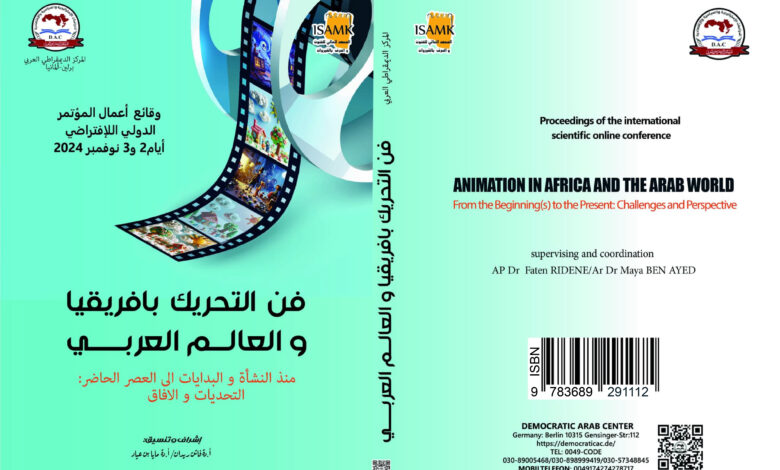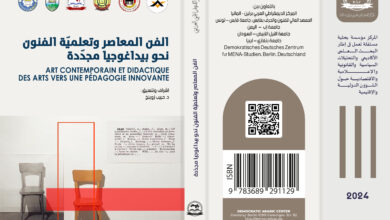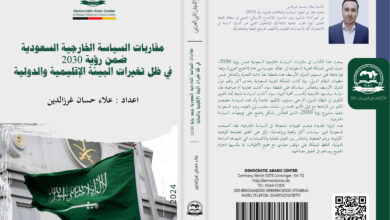فنّ التحريك في إفريقيا والعالم العربي منذ النشأة والبدايات إلى العصر الحاضر : التحدّيات والآفاق
ANIMATION IN AFRICA AND THE ARAB WORLD From Geneses to Present Day: Challenges and Perspectives

من أجل تأسيس التواصل والتفاعل بين الثقافات المختلفة وتشكيل مجتمع علمي يضم باحثين من المحيط إلى الخليج إضافة لمعالجة المشاكل الحضارية المشتركة.
ضمن هذا السياق يسعدنا في #المركز_الديمقراطي_العربي (مؤسسة بحثية) ومقره ألمانيا – برلين بالتعاون مع: –
- المعهد العالي للفنون والحرف القيروان – جامعة القيروان – تونس
- Demokratisches Deutsches Zentrum für MENA-Studien, Berlin, Deutschland
كتاب وقائع أعمال الـمؤتمـر الـدَّولـي العلمي :-
فنّ التحريك في إفريقيا والعالم العربي منذ النشأة والبدايات إلى العصر الحاضر : التحدّيات والآفاق
ايام 2 – 3 / 11 / 2024 م اقامة المؤتمر حضوريّا في جامعة القيروان بالتوازي مع المهرجان الدّولي للأفلام التّحريكيّة بالقيروان & وايضا بواسطة تقنيَّة التَّحاضر المرئي عبر تطبيق Zoom
تحميل نسخة pdf –
الطبعة الأولى “2024″كتاب: –
فنّ التحريك في إفريقيا والعالم العربي منذ النشأة والبدايات إلى العصر الحاضر : التحدّيات والآفاق
جميع حقوق الطبع محفوظة : للمركز الديمقراطي العربي ولا يسمح بإعادة إصدار هذا الكتاب أو اي جزء منه أو تخزينه في نطاق إستعادة المعلومات أو نقله بأي شكل من الأشكال، دون إذن مسبق خطي من الناشر .
مقدمة : –
إنّ تصدّر فنّ التّحريك العربي والإفريقي واجهة المشهد العالمي يُفسّر في –في جزء كبير منه- بتجدّد الاهتمام والرّغبة في اكتشاف هذه المجتمعات منذ الاستفاقة الشّعبيّة لسنة 2011. بالرّغم من لفت النّظر إليه أو حصوله على تتويجات في المهرجانات الأكثر شهرة (انيسي، كان والبارلينال)، وبالرغم من كونه موضوع تظاهرات ثقافية حصريّة فانّه نادرا ما يتم التطرّق اليه كموضوع بحث بمقاربة كليّة. وهو غالبا ما يعتبر منتجا ثقافيا يلقي الضّوء على التحوّلات الكبرى والطّفرات الاجتماعيّة والسياسيّة في المنطقة اذ لا تزال البحوث في مجال دراسات فنّ التّحريك المتّصلة بالفضاء الثّقافي العربي وخاصّة في القارة الافريقيّة في أولى أطوارها، كل هذا رغم نهضة هذا النّوع والطّفرة الانتاجية اللّتان رافقتا الثّورة التّكنولوجيّة والرّقميّة منذ بداية القرن الحالي. تمّ تحرير ممارسة هذا التّعبير الفنّي والتّقنية الفنيّة من القيود الماديّة والماليّة الخاصّة بهذا النّوع (كامرا، آلة عرض، شريط، الخ) عبر “دمقرطة” الوسائل الرّقميّة.
وقد لاحظت مورين فورنيس (2007) هذه الوضعيّة الهامشيّة لسينما التّحريك في الجامعة مقارنة بنظيرتها “الاخرى” أي السينما الى حدود نهاية الثّمانينات1980 (وهذا بالنّسبة الى المثال الأمريكي). سلّطت الكاتبة الضوء على سياق ظهور دراسات فنّ التّحريك في الولايات المتّحدة وفسّرته من جهة بتأثير تيّار ما بعد الحداثة على دراسات الميديا والذي اضفى مشروعيّة على دراسة الأشكال الشّعبيّة للفنّ والتّرفيه (التي اعتبرت خطأ أقلّ “جديّة”) ومن جهة أخرى بضرورة توثيق وترسيخ الذّاكرة الزّائلة لهذا الفنّ.
ومن المفارقات أنّ الإنتاجات السينمائية التّجاريّة المهيمنة على الشّاشات الصّغيرة والكبيرة هي التي تحشد الخطابات والكتابات حول هذا النّوع.
إنّ الإنتاجات السينمائية الحكوميّة على غرار فنّ التّحريك الكندي الذي تمّ دعمه بشكل رئيسي من قبل الديوان الوطني للفلم، أو الإنتاجات السينمائية لشّرق اروبا التي تحظى بوضعيّة مميّزة من طرف الأنظمة الاشتراكيّة (مقارنة ببلدان أخرى) تجد نفسها على هامش الأدبيات الدّائرة على فنّ التّحريك رغم أنّها لا يُعوِزُها “البروز”: الاعتراف الدّولي، الجوائز والتّكريمات في المهرجانات (س. باهون :2014، بيكوف: 2019 م، جان:2008).
لم تزل الإنتاجات السينمائية لفن التّحريك في افريقا والعالم العربي تجد نفسها على هامش الهامش في الدّراسات الفيلمية ودراسات فنّ التّحريك. بالرغم من ذلك فانّ منشأ الفلم في هذه الفضاءات الثقافية والجغرافية يعود الى بداية القرن الماضي، اذ انّ واحدا من اول افلام فنّ التّحريك في القارّة تمّ انجازه في1915 في جنوب افريقيا من قبل الأمريكي هارولد شاو “حلم الفنّان”(بندازي،2015). كما انّ فنّ التّحريك المصري رائد في افريقيا والعالم العربي بسلسلة الرّسوم المتحّركة “مشمش أفنديّ” للأخوين فرنكل المهاجرين البلاّروسيين في مصر، حيث كان أوّل عمل ابداعي لهما في1936. وستُعقب هذه التّجربة في 1940 ب”دكدك” الذي أنجزه المصري انطوان سليم ابراهيم الذي هاجر في سنوات السبعينات1970 الى الولايات المتّحدة اين التحق باستوديو (حنّا باربرا) باعتباره فنّان تحريك. وخلال عشريّة السّتينات 1960 نال عدد لا بأس به من هذه الشّعوب استقلاله ووافق ذلك ميلاد السّينما الافريقيّة و العربيّة.
أسّس الأخوان مهيب المجازان من مدرسة القاهرة للفنون الجميلة في1961 قسما لفنّ التّحريك بالتّلفزيون المصري(غزالة،2021). كما أنجز الرسّام الكاريكاتوري عصامي التّكوين محمد عرام افلام قصيرة لفنّ التّحريك للتّلفزيون الجزائري اذ سيّر قسم فنّ التّحريك الذي تأسّس في1964 بالمركز الوطني للسينما. وفي السنة نفسها 1965 تمّ إنجاز اوّل الافلام الافريقيّة: “موت غانجي” من قبل النّيجيري مصطفى الحسن اثناء اقامته الدّراسيّة بالديوان الوطني للفلم (كندا) و”العودة الى مقاعد الدّراسة” من قبل التّونسي منجي سانشو في إطار جمعياتي (جمعيّة المخرجين الشّبان التّونسيين) التي اصبحت في1968 الرابطة التّونسيّة للسينمائيين الهواة. ذهب منجي سانشو الى شرق اروبا سنة 1967 وتحديدا الى بلغاريا (بن عيّاد،2019) لإتمام دراسته. وهو شأن عدد كبير من روّاد فنّ التّحريك التّونسيين وكذلك رواد فنّ التّحريك في بلاد الشّام فقد أنجز الرسّام الكاريكاتوري السّوري موفّق قط المُجاز من معهد جيراميسوف للسينماتوغرافيا في 1982 اوّل فلم تلفزي لفن التّحريك السّوري “جحا في المحكمة” في1985، وأنجز المخرج العراقي فيصل الياسري الحاصل على شهادة في الاخراج التّلفزي من فيانا والذي كان مخرجا في تلفزيون ألمانيا الشّرقية(جمهوريّة المانيا الدّيمقراطيّة سابقا) في نهاية الخمسينات1950 وبداية السّتينات أوّل فلم عربي طويل لفنّ التّحريك “الأميرة والنّهر” سنة 1982 .
وفي اواخر الثمانينات1980 أسّس الكونغولي ورائد فلم التّحريك جان ميشال كيبوشي المجاز في دراسات التّصوير السينمائي من المعهد الوطني للفنون في كينشاسا وبعد ان تابع تكوينا في فنّ التّحريك تابعا للشركة البلجيكيّة ورشة قارفوي اسّس استوديو فيلم التّحريك مالمبي ما. بالإضافة الى انتاج اعمال المخرج، ينظّم الاستوديو المتنقّل ورشات عمل موجهة للشّباب. فقد كان الهدف التّرويج لفنّ التّحريك بما هو امتداد طبيعيّ للأشكال والتّراث الثّقافي الكونغولي (كاليس،2010). وفي الفترة نفسها، في 1989 انجز المالي مامباي كوليبالي “ملحمة سيغو” وهو على حدّ علمنا الفلم الاوّل من نوعه في البلاد.
انّ فيلم التّحريك العربي والافريقي رغم كونه غير معروف بالقدر الكافي الى حدّ اليوم قد سجّل حضوره بجدارة في التّاريخ العالمي لفنّ التّحريك. ومع ذلك على الرغم من ظهوره في اوقات مختلفة في هذه المنطقة الشّاسعة، الاّ انّ نشأته وتطوّره قد تأثّرا بقوّة بالأممية القاريّة الثلاثية وبالحركات القومية الافريقية والعربيّة في ستينات وسبعينات القرن الماضي. ولأنها ملتقى للثقافتين الافريقيّة والعربيّة وباعتبار مهرجان أيام قرطاج السينمائية (1966) مثّلت العاصمة التونسيّة خلال هذين العقدين مع فيسباكو(1969) في واغادوغو في بوركينافاسو فضاءات للتّفكير والنّقاش حول الدور البيداغوجي والفني لهذه الصّناعة في رفع درجة الوعي في “بلدان الجنوب”. فما هو حال هذا الارث اليوم في عصر العولمة؟
الهدف الاوّل لهذا المؤتمر، الى جانب تجديد الادبيات العالمية حول فنّ التّحريك، هو تسليط الضّوء على هذه السينماءات التي لم يُتطرق اليها في الادبيات الدّائرة على الصّناعة السينمائيّة. انّ اهتراء اشرطة الاعمال الاولى وغياب الرواد (على غرار: محمد عرام او مصطفى الحسن الخ) اضافة الى سرعة زوال الاعمال المعاصرة (“الويب انيمس” التي توزّع حصريّا على الأنترانت والتي تضمحل في خضم تدفّق المعلومات) هو ما يجعل من حفظ الذّاكرة وتوثيق هذه الاعمال السينمائيّة اولوية. يتعلّق الأمر إذا بضرورة توثيق فنّ التّحريك لهذه الفضاءات الجغرافية المهمشة وادراجه في التّاريخ العالمي لهذا الفنّ، وكذلك في التّاريخ الثّقافي و التّراثي لهذه المجتمعات.
الهدف الثّاني هو وضع الخطوط العريضة للحقل النّظري لفنّ التّحريك الافريقي والعربي، من خلال مقاربته باعتباره موضوعا كليا. فلا نُعنى بالعمل النّهائي فحسب، بل بالايكوسيستام الذي يساهم في انتاجه وتكوين صنّاعه وصولا الى مسالك توزيعه المختلفة. وتعد طبيعته الهجينة جوهريّا (فنّا وتقنية) وارتباطاته المعقّدة بالتّعبيرات الفنيّة الاخرى، وضعيته الهامشيّة في عالم السينما و الجامعة و اعتباره شاهدا اجتماعيا على التحوّلات الكبرى المحاور الكبرى الجديرة بالدّرس.
Abstract
Arab and African animation has come into the spotlight, gaining more visibility in international festivals by virtue of a renewal of interest and curiosity for these societies since the popular uprising of 2011. Despite being noticed and/or awarded at the most prestigious festivals (Annecy, Cannes, the Berlinale) as the subject of exclusive cultural events, animation is rarely approached as an exclusive study object but often as a cultural product that highlights the socio-political upheavals in the region
Animation Studies in the Arab world, and even more so on the African continent, are still in their embryonic stage, despite a renaissance of the genre and the production’s boom since the early 2000s accompanying the technological revolution
The “democratization” of digital tools has freed the practice of this artistic expression and technique from the financial and technical constraints specific to the genre (Rostrum camera, filmstrip, etc.)
Maureen Furniss (2007) noted this marginal status of animation at university compared to “the other” cinema until the late 1980s. The author sheds light on the context of emergence of Animation Studies in the United States. She explains this in terms of the influence of postmodernism on media studies, which legitimized the study of popular forms of art and entertainment (wrongly considered less “serious”), on the one hand, and the urgent need to document and trace the “evanescent” memory of this art form, on the other
Somewhat paradoxically, it’s hugely the mass-market and commercial cinemas, with their hegemonic presence on both large and small screens, which mostly mobilized discourses and writings on the genre. State cinemas such as Canadian animation, mainly supported by the National Film Board, or Eastern European cinemas benefiting from a privileged status under socialist regimes (compared to other countries) find themselves on the bangs of animation literature. Even though they are not lacking in “visibility”: international recognition, prizes, and awards at festivals (S. Bahun: 2014, Ü. Pikkov: 2018, M. Jean: 2008)
Animated films from Africa and the Arab world are at the edges of the margins of film and animation studies despite the fact that the animation’s genesis in these cultural and geographical areas goes back to the early years of the last century. One of the continent’s first animated films was made in 1915 in South Africa by the American Harold Shaw, The Artist’s Dream (Bendazzi, 2015). Egyptian animation was also a pioneer in Africa and the Arab world, with the Frenkel Brothers’ Mish-Mish Effendi, Belarusian immigrants in Egypt whose first opus dates from 1936. This experience would be followed by Dokdok in 1940, directed by the Egyptian Antoine Selim Ibrahim who immigrated to the United States in the 1970s where he joined the Hanna Barbara Studios as an animator. The decade of the 1960s, when many of these nations gained independence, also marked the birth of African and Arab cinema
In 1961, the Moheeb brothers, Cairo School of Fine Arts graduates, founded an animation department in Egyptian television (Ghazala, 2021). The cartoonist Mohamed Aram, who self-taught to produce animated shorts for Algerian television, headed the animation department founded in 1964 at the Centre National du Cinéma. The same year, 1965, saw the production of the first African films: La mort de Gandji by Nigerian filmmaker MoustaphaAlassane during his study period at the National Film Board (Canada), and La rentrée des classes by Tunisian filmmaker Mongi Sancho as part of an association (Association des Jeunes Cinéastes Tunisiens, which became the Fédération Tunisienne des Cinéastes amateurs in 1968). Like many of Tunisia’s animation pioneers, Mongi Sancho left to complete his studies in Bulgaria in 1967 (Ben Ayed, 2019)
This is also the case for the pioneers of animation in the Levant, Syrian cartoonist Mwafak Katt, who graduated from the VGIK in 1982 and made the first Syrian animated film, Juha Fi Al-Mahkameh, for television in 1985, and Iraqi filmmaker Fayçal al-Yasiri, who graduated in television directing in Vienna and worked for East German (ex-GDR) television in the late 1950s and early 1960s, made the first Arab animated feature film, The Princess and the River, in 1982. At the end of the 1980s, Congolese animation pioneer Jean Michel Kibushi, who graduated in film studies from Kinshasa’s National Institute of the Arts and received animation training from the Belgian company Atelier Garphoui, founded the Malembe Maa animation film studio. In addition to producing the director’s works, the mobile studio organizes workshops for young people. The aim is to promote animation as a natural extension of Congolese cultural forms and heritage (Callus, 2010). At the same time, in 1989, Malian director MambayeCoulibaly directed an animation film, La geste de Ségou, which was, as far as we know, the first of its kind in the country
African and Arab animation, though still little known today, is an integral part of the global history of animation. Although it emerged at different times in this vast region, its genesis, and evolution were strongly influenced by tricontinental internationalism and the pan-African and pan-Arab movements of the 1960s and 1970s. The Tunisian capital, at the crossroads of two African and Arab cultures, and its JCC (1966), along with FESPACO (1969) in Ouagadougou, Burkina Faso, were spaces for reflection and aesthetic debate on the educational and artistic vocation of cinema and its mission to awaken consciousness in the countries of the South. What has become of this heritage in today’s global age
The primary aim of this conference is to bring attention to film production that is still barely explored in film discursive practices and to expand the existing knowledge base on film and animation. The vulnerability of early movies due to the use of the silver medium, the loss of pioneers like Mohamed Aram and Moustapha Alassane, and the transience of contemporary works, such as web animations created exclusively for the Internet and quickly overshadowed by the constant flow of information, all contribute to the urgency of documenting these cinemas. There is a pressing need to record the history of animation in these unexplored regions and to integrate it into the global narrative of this art form and the cultural and heritage history of these societies
The second objective is to map the theoretical field of African and Arab animation by approaching it as a whole. By “a whole”, we mean not only the final artwork but the whole ecosystem involved in its production, from the training of its authors to the various circuits of its distribution. This conference will focus on its inherent hybridity (between art and technology), its multi-layered filiations with other artistic expressions, its marginal status as a practice and in film studies, and how animation can be a social witness to major transformations
فهرس المحتويات
الناشر: المركز الديمقراطي العربي للدراسات الإستراتيجية والسياسية والاقتصادية
Democratic Arabic Center- Berlin – Germany





